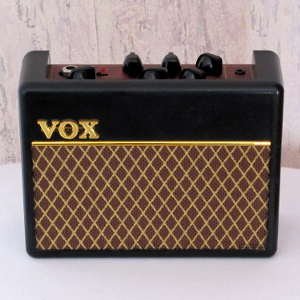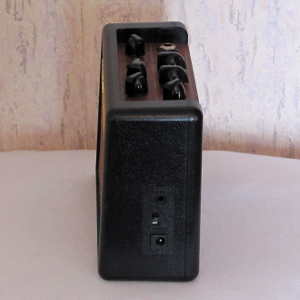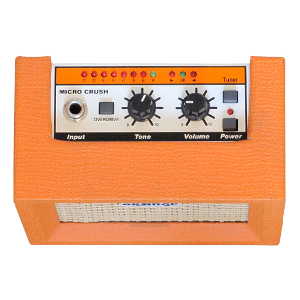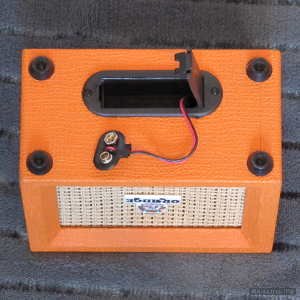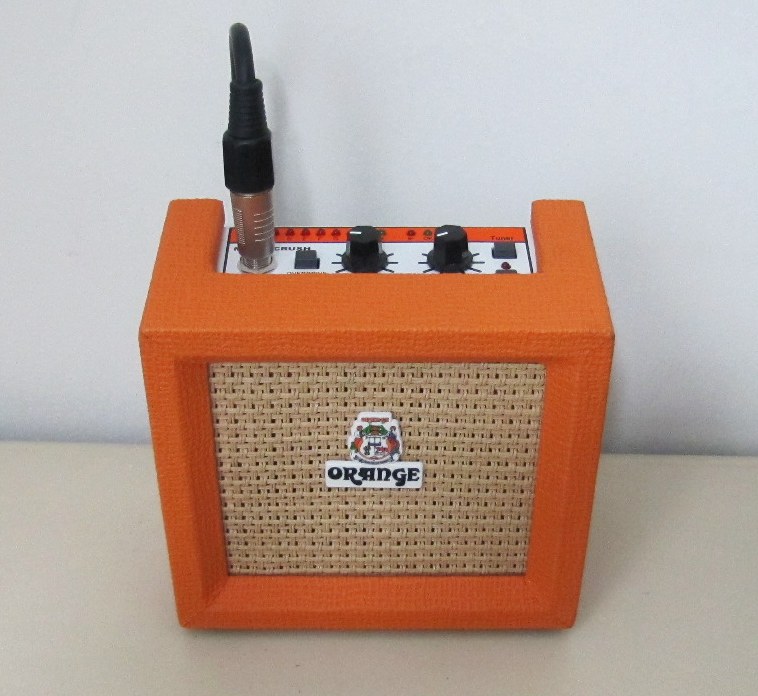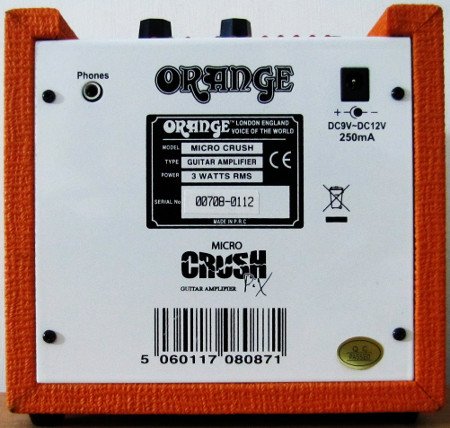Highly portable guitar amp reviews:
Vox AC1 and Orange Micro Crush PiX
As a lover of guitar mini toys I was looking at many compact guitar amps on the market lately. I wanted to get an analog (not modeling), very portable amp with as big sound as possible for practicing outdoor, using it on its own and as well as with external effects pedals.
I researched a plenty of specs, reviews and demos online of various amps and the Vox AC1 RhythmVOX along with the Orange Micro Crush CR3 (PiX) looked most appealing to me. Especially the Orange Crush, because of the wood cabinet, and as was mentioned in one review I read it has a "serious" 3 watt, 4 inch speaker with the heavy magnet on it.

I know it might sound funny but for this kind of amp it's an awesome
combination that in theory should bring good results.
On the other hand the Vox AC1 has two, but pretty tiny speakers 0.8 watt, 3 inch each,

anyway many reviews stated that the amp sounds really good for its size. Moreover it has a handy drum machine on board that is a big plus for practice.
I was hesitating which of these amps to buy and finally bought them both.
Some time ago the Blackstar Amplification company also started manufacturing a 3 Watt mini guitar amp called 'FLY 3'.
The amplifier can run off 6 AA batteries, has some nice features like built in delay effect with 'delay level' and 'delay time' knobs, Line In, 'Infinite Shape Feature' 1 knob EQ control that tweaks the tone more towards "American" or "British" characteristic, an input to connect a 'FLY103' extension cabinet to create 6W stereo set-up.
This is definitely another interesting option to explore if you are contemplating on buying a portable guitar amp.
Beware, though: the FLY3 cannot be powered by a generic 9 volt DC (center negative) power supply that can be used with the majority of guitar pedals (and with the Vox AC1 and Orange Micro Crush amplifiers as well).
Instead, it provides its own 6.5 volt power adapter.
When I travel, I prefer to run my portable setup from a single power source (usually a 5 volt USB rechargeable battery connected to a 5-to-9 volt adapter) and because of that, this amp is not a viable option for me.
Look and feel
As you know there's no doubt that the both amps look very attractive and cute, the Vox AC1's cabinet is made of plastic and the amp feels super light, about of a weight of a standard guitar effects pedal like Boss or Digitech and it's a really cool gadget to take on the road when the space and weight is especially an issue.
The Orange Micro Crush is a little bit bigger, its cabinet is made of wood covered with tolex, and the rear side is metallic, the construction feels really sturdy and the weight of the Orange is about twice of the Vox amp.
The clean sound
Both these mini amps sounds very well for their size and have a tone knob for some EQ tweaking. The Orange is projecting much bigger bass though. The Vox tends to break up (negatively distort) the sound when turned loud, and better suited where little volume is required.
Another thing I noticed here is that the Vox sounds pretty straight and transparent while the Orange subtly modifies the tone, but not in a bad way.
(neck pickup)
Although the mic recorded some hiss you can hear here, it wasn't actually audible when I was playing and the both amps are not noisy at all on the clean channel.
Dirty sound
First of all along with the clean/overdrive switch the Vox also has a 'gain' knob for tweaking the level of the overdrive. These two things together allow to get a range of tones out of the little box.
Even if the swtich is on 'clean' but the gain knob is about 3 o'clock it creates a subtle overdive effect that adds some little dirt when playing chords.
When the switch is set to the 'dirty', turning the gain knob can bring you from the light overdrive to the rich creammy overdive/distortion sound that is exelent for playing solos, and in the same time can get you a classy rocky crunch when playing power chords riffs, but unfortunately it begins to choke and easily gets deformed on the lower strings especially when the 'palm mute' technique is involved.
With some experimenting I found that decreasing the volume on the guitar by about 30% cleans up the mess and eliminates these 'sound deformations'.
The Orange PiX has only 'clean/overdrive' switch, no gain knob, but you can control the gain using the volume knob on your guitar.
When the volume knob is on max, the Orange has "sawing", "granular" distorted tone that sounds kind of plastic on lead parts. When riffing though it has some nice, light crunch. The Orange amp doesn't start chocking on high gain settings like the Vox does and behave in a way like a normal amp.
Tuning the guitar's volume knob down decreases the intensity of the distortion, and in the same time makes the "grains" and "plastic" vanish out of the sound, making it warmer and much more pleasant to the ears.
Mild Gain
(neck pickup)
High Gain
(bridge pickup)
I used the bridge pickup for the riff in the beginning and the neck pickup for the subsequent eastern sounding improvisation.
Here are some extra licks I played with the Vox AC1 to show off more how creamy and sweet its overdrive is:
(bridge pickup)
Using the amps with external pedals effects
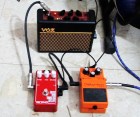
First of all using an external distortion/overdrive pedal makes sense if you want to use delay, reverb or any modulation effect pedal along with the distorted guitar. Because those effects should go after the distortion or overdrive, or otherwise you'll get a weird diffused tone, you can't use them with the on board overdrive.
If, for instance, you prefer to use overdriven sound with the delay effect, you should plug your guitar into the overdrive pedal, overdrive into the delay and the delay into the mini amp.
Here are the audios I recorded putting the BOSS DS-1 classic distortion and Malekko Ekko 616 analog delay pedal between the guitar and the amps. I used the neck pickup to achieve this smooth tone:
(neck pickup)
By the way just putting the same BOSS DS-1 between the guitar and the Orange on the clean channel gave me pretty good distorted tone, without unpleasant "sawing" effect when playing leads, and added a lot of dimension to the crunch when playing power chords.
(bridge pickup)
What I noticed about the Vox though is that any external effect that boosts the volume can easily break up the the amp's sound. So when using the same DS-1 distortion with the Vox I roll the level knob on the pedal down a bit.
Putting the 'HardWire TL-2' high gain metal distortion gave me not bad results too, especially for the Orange. Note that I tweaked all the 4 EQ knobs on the pedal differently to make it better suitable for each mini amp.
(bridge pickup)
Extra features
Both these portable amps have a built in chromatic tuner. The tuner in the Vox AC1 can only detect note of E on any octave though.

So you can tune the low and high E string with the tuner and the rest by 'from string to string method'. Or you can tune all the strings with the tuner pressing them at the frets that will give you the note of E.
- A string - 7th fret
- D string - 2nd fret
- G string - 9th fret
- B string - 5th fret
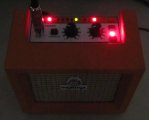
The tuner on the Orange Micro Crush doesn't have this limitation and it's able to recognize any note you play, and the unusual design twist of the indicator that is made of LEDs looks cool especially in the dark.
I compared how this tuner works to the tuner on my BOSS BR-600 recorder that is really accurate. Sometimes when the Orange's tuner showed the string is already in tune, the Boss' tuner indicated that the pitch is still a very little out.
Anyway this amp wasn't designed for studio sessions where super correct pitch is required and for outdoor playing this tuner is a big help.
Both amps have a headphone jack, but to say honestly they both do not sound great through the headphones. (I used SONY MDREX58V earbuds).
The Vox AC1 has an additional 1/4" input jack to connect an mp3 player or any other audio device. Sometimes I use this amp as a mobile stereo system for my laptop when on the go. It's a great solution for boosting the volume when watching movies, but not for general music listening because this is a guitar amp and it's optimized to work only with certain frequency range. Although by tweaking the EQ on my laptop I managed to get some improvements.
Another pleasant feature that has only the Vox AC1 amp is the drum machine with a dedicated volume control where the speed is handy controlled by the knob.The drum machine has 66 patterns covering most styles, even funk, reggae and triplet rhythm.




